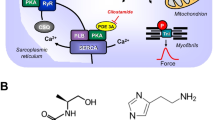Abstract
The vascular endothelium modulates relaxation and contraction of blood vessels. Since endothelial cells respond to a variety of vasoactive substances, it was suggested that specific cell membrane receptors exist on the endothelial cells which are responsible for the modulatory role of the endothelium on the blood vessels. We therefore investigated the localization and binding characteristics of histaminergic H1-receptors in the vascular model system of the bovine thoracic aorta. Our earlier binding experiments showed that histaminergic H1-receptor binding sites labelled with [3H]mepyramine are present on the vascular smooth muscle membranes of this tissue. In addition a small number of specific H1-receptor binding sites also exist on the endothelial cells of this tissue with the following binding characteristics: Bmax=34.6 fmol [3H]mepyramine/mg protein, KD=2.13 nM. [3H]mepyramine binding is more effectively inhibited by H1- than H2-receptor agonists and antagonists. These results provide evidence for the existence of endothelial histaminergic H1-receptor binding sites in addition to vascular smooth muscle H1-receptors in the bovine thoracic aorta.
Similar content being viewed by others
References
P. M. Vanhoutte and T. J. Rimele,Role of the endothelium in the control of vascular smooth muscle function. J. Physiol. (Paris)78, 681–686, (1982–1983).
M. Čarman-Kržan,Specific binding of [3 H]mepyramine to histamine H 1-receptors in vascular smooth muscle membranes. Agents and Actions13, 162–166 (1983).
O. H. Lowry, N. J. Rosebrough, A. L. Farr and R. J. Randall,Protein measurement with the folin phenol reagent. J. biol. Chem.193, 265–275 (1951).
Y. C. Cheng and W. H. Prusoff,Relationship between the inhibition constant (K i )and the concentration inhibitor which causes 50 per cent inhibition (IC 50)of an enzymatic reaction. Biochem. Pharmac.22, 3099–3108 (1973).
G. Scatchard,The attraction of protein for small molecules and ions. Ann. N.Y. Acad. Sci.51, 660–672 (1949).
M. Čarman-Kržan,Characterization of vascular histamine H 1-receptors: multiple affinity states of aortic histamine H 1-receptor. Agents and Actions16, 179–182 (1985).
M. Čarman-Kržan,Regulation of membrane histamine H 1-receptor binding sites by guanine nucleotides, mono and divalent cations. Agents and Actions18, 120–123 (1986).
M. Čarman-Kržan,The effect of group selective reagents N-ethylmaleimide and dithiothreitol on histamine H 1-receptor binding sites in the vascular smooth muscle membranes. Agents and Actions14, 561–565 (1984).
Author information
Authors and Affiliations
Rights and permissions
About this article
Cite this article
Čarman-Kržan, M. Histaminergic H1-receptors in smooth muscle and endothelium of bovine thoracic aorta. Agents and Actions 27, 198–201 (1989). https://doi.org/10.1007/BF02222238
Issue Date:
DOI: https://doi.org/10.1007/BF02222238



